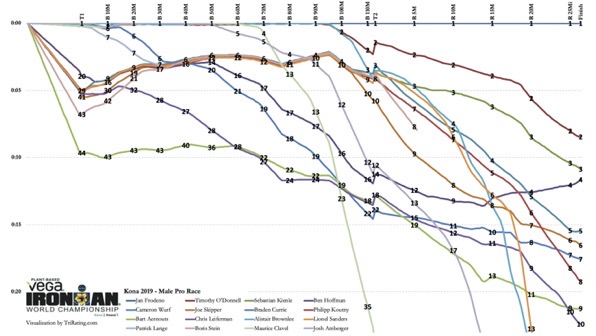Here are the results of the top finishers and the athletes that had an influence on the outcome of the MPRO race (full results can be found here, a similar detailed look at the women’s Pro race is in the works):
| Rank | Name | Nation | Swim | Bike | Run | Time | Diff to exp. | Prize Money |
| 1 | Jan Frodeno | GER | 00:47:31 | 04:16:02 | 02:42:43 | 07:51:13 | -05:27 | US$ 120,000 |
| 2 | Timothy O’Donnell | USA | 00:47:38 | 04:18:11 | 02:49:45 | 07:59:41 | -14:44 | US$ 60,000 |
| 3 | Sebastian Kienle | GER | 00:52:17 | 04:15:04 | 02:49:56 | 08:02:04 | 02:54 | US$ 40,000 |
| 4 | Ben Hoffman | USA | 00:51:01 | 04:24:01 | 02:43:08 | 08:02:52 | -08:39 | US$ 22,500 |
| 5 | Cameron Wurf | AUS | 00:52:25 | 04:14:44 | 02:55:03 | 08:06:41 | -08:38 | US$ 19,000 |
| 6 | Joe Skipper | GBR | 00:52:28 | 04:16:18 | 02:53:30 | 08:07:46 | -09:42 | US$ 16,000 |
| 7 | Braden Currie | NZL | 00:47:41 | 04:30:30 | 02:46:25 | 08:08:48 | -05:06 | US$ 14,000 |
| 8 | Philipp Koutny | SUI | 00:52:20 | 04:15:14 | 02:57:50 | 08:10:29 | -16:10 | US$ 12,500 |
| 9 | Bart Aernouts | BEL | 00:57:03 | 04:19:47 | 02:51:08 | 08:12:27 | -02:03 | US$ 11,000 |
| 10 | Chris Leiferman | USA | 00:52:29 | 04:24:20 | 02:52:19 | 08:13:37 | -00:16 | US$ 10,000 |
| 21 | Alistair Brownlee | GBR | 00:47:33 | 04:19:58 | 03:13:00 | 08:25:03 | n/a | |
| 22 | Lionel Sanders | CAN | 00:52:22 | 04:15:22 | 03:13:42 | 08:25:54 | 11:21 | |
| 33 | Josh Amberger | AUS | 00:47:28 | 04:27:16 | 03:25:25 | 08:44:29 | 19:57 | |
| 38 | Maurice Clavel | GER | 00:47:40 | 04:38:33 | 03:28:39 | 09:01:05 | 43:56 | |
| Boris Stein | GER | 00:54:15 | 04:13:18 | DNF | ||||
| Patrick Lange | GER | 00:47:40 | DNF |
Here’s the Race Development Graph for these athletes (click for a hi-res version):
Here are the main groups that formed during the race:
- Front Group in Swim
This year a true front group of eight athletes was able to build a decent gap of more than three minutes into T1. The group wasn’t just strong swimmers, most of the athletes in the front group were also ready to push the pace on the bike and stay away from the rest of the field. The way the race developed it’s no surprise that both winner Jan Frodeno and second-place Tim O’Donnell were in this group. - Swim Chase Group
The second swim group was a lot smaller than what we’ve seen in the past – and without a strong biker willing to set the pace they were quickly joined by the “third group” that had the slower swimmers but strong bikers. No one from the second group was able to stay with the “bike power” when the climb to Hawi started. There were a few good results by those in the second group (most notably, Ben Hoffman in fourth), but they needed a strong run to place well. - Bike Chase Group
Quickly after the swim, a strong bike group of seven athletes formed around Cam Wurf, Sebastian Kienle and Lionel Sanders. They overtook the athletes from the swim chase group and started to eat into the lead to the front but never came closer than two minutes, at the gap at the turnaround in Hawi. The best runner in this group was Sebastian Kienle who took third place.
Kona Champion: Jan Frodeno
The graph for Jan’s race is relatively uneventful – he was always at the front of the race:

However, the graph does not tell the full story of the masterclass he delivered in Kona. He was swimming in the first group with Josh Amberger, building a gap of more than three minutes to the rest of the field. On the bike, the lead swim group stayed away from the rest of the field. Initially, the group consisted of nine athletes, before the climb to Hawi it had shrunk to five, then Josh Amberger and Maurice Clavel also fell away. After 95 miles, Jan didn’t seem to be too happy with the pace and tried to rally Tim O’Donnell and Alistair Brownlee, the last two who were able to stay with him. When they didn’t share in the work, he put in a last hard effort on the bike and dropped them. After the race Jan said that this was one of those awesome races where the body was just able to deliver what he asked for. (Check out his interview with Bob Babbitt after the race.)
By T2 he was 2:19 in front of TO, then took some extra time in T2 to cool down a bit further. (You can see in the graph how almost everyone made up time to him in T2.) At the start of the run the gap was down to 1:27 but once he started running on Ali’i, Jan was able to extend the gap to 2:42 at Palani (after 7.3 miles) and to 4:08 at the turn in the Energy Lab (16.2 miles). Jan posted the fastest marathon of the day (2:42:43), winning with a new course record (7:51:13) and a margin of 8:28, the largest winning margin since 2004 when Norman Stadler won by more than ten minutes in front of Peter Reid.
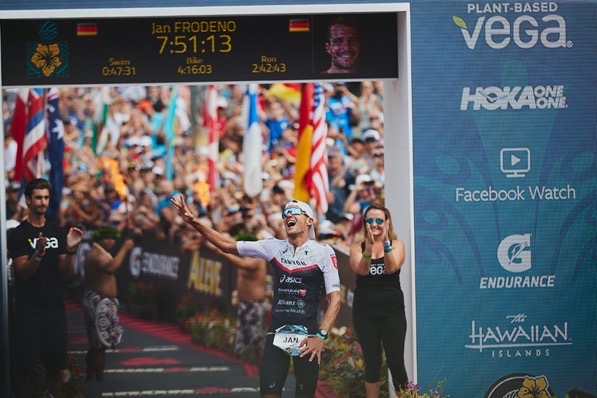
It’s hard to imagine how anyone could have been able to beat him this year with the tactics he chose and the performance he was able to show whenever it mattered. For comparison purposes: Even if Patrick Lange had been healthy and able to ride with the big group as he did last year (a shaky proposition given that there was a lot more bike power in the group this year), he would have been at least 3:30 behind Frodo at the start of the run – meaning he would have had to run a new run course record of low-2:39 just to be able to catch up to Frodo – a lot of pretty big “if’s”! It’ll be a tricky puzzle for the other athletes to come up with a strategy on how to put more pressure on Frodo for next year’s race.
Second Place: Tim O’Donnell
American Tim O’Donnell was able to improve on his fourth-place from last year and a third place in 2015. He finished second even after a less-than-optimal 2019 season:

He was swimming with the front group and then was also able to stay with Frodo for most of the bike. He kept the pace honest after the turnaround in Hawi, and even if he was dropped by Frodo in the last part of the bike, he didn’t lose too much time and started the run in second place, about two minutes behind the lead but also two minutes ahead of the other podium contenders. With a running injury most of his Kona run training was done by pool running, and he was close to pulling out a few weeks out. But he felt good once on the run in Kona. Even if he was losing time to Frodo, he was able to keep the gap to the other runners around two minutes and didn’t seem to have many “low points”. He claimed second place with a 2:49:45 marathon, was the first American to go sub-8 in Kona – and also set a new “family Kona run record” held until this year by his wife Mirinda Carfrae with a 2:50:26 from 2014.
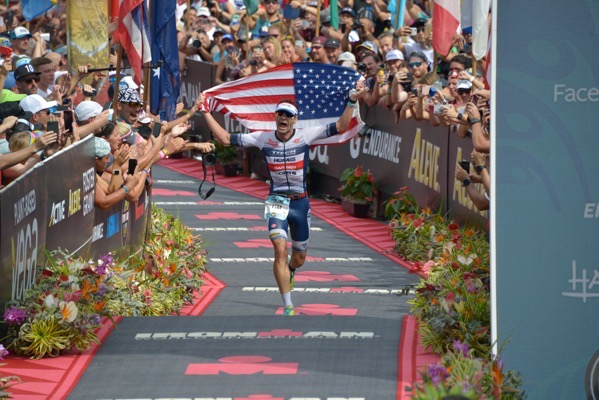
Third Place: Sebastian Kienle
After last year’s DNF, Sebastian Kienle was able to add another Kona podium to his palmares:

The typical question for Sebi’s swim is “how much time does he lose”. This year he was just under five minutes behind the swim leaders and about 90 seconds behind the swim chase group. He was probably hoping to be a bit closer to the front, but it was still better than in 2017 when he was more than four minutes behind the group or in 2016 when he started the bike with a three-minute deficit to most of the other contenders. As in 2017 Lionel Sanders and Cameron Wurf were within a few seconds of him, and it took the strong bikers only ten miles to bridge up to what is usually the “main group” on the bike. Apparently Sebi was content to have Cam Wurf set the pace and see the gap to the front of the race slowly coming down. However, at the turn in Hawi the gap was still over two minutes and then even got larger again. It’s not clear if that was a result of hard riding at the front or the pace slowing down a bit in the chase group, but the gap was 4:02 for Sebi at the end of the bike.
As was expected before the race, Sebi was running well and he was able to quickly overtake Alistair Brownlee, Lionel Sanders and Cam Wurf after they had surged a bit out of T2. Towards the front, Frodo was more than four minutes ahead in the lead, and Sebi was more than two minutes behind Tim O’Donnell and not making up time to him. But for most of the run he was extending the gap to fourth place, until at the very end Ben Hoffman was running extremely well and Sebi had to dig deep to keep a margin of less than a minute to Ben.
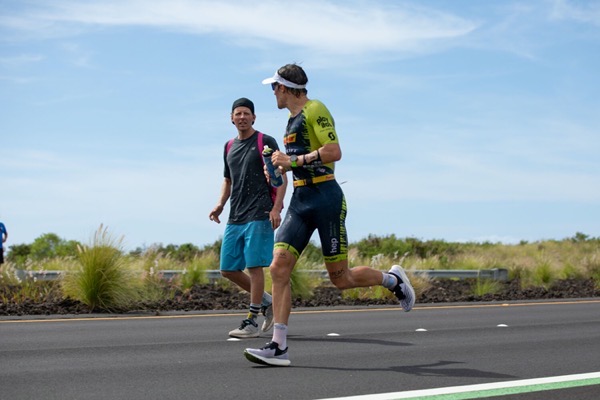
Overall, it was a solid third place for Sebi. On one hand, this will be a result he’s happy with after last year’s DNF and his extended rehab over the winter. On the other hand, he’s had the worst relative performance among the Top 10, about three minutes slower than what was expected from his previous results, whereas Frodo and TO were five and almost 15 minutes quicker than expected. This shows that Sebi probably didn’t have a stellar day in Kona and that he has some untapped potential for next year’s race.
Fourth Place: Ben Hoffman
Ben’s race day had a good start and end, but a challenging “middle leg”:
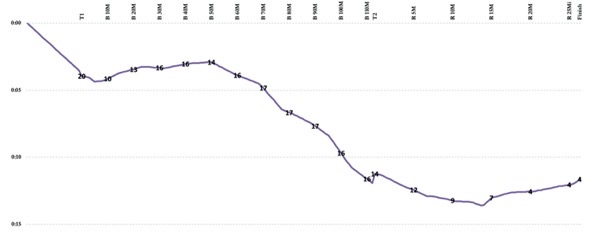
Ben was able to swim with the main group and started the bike exactly four minutes behind the leaders. He was able to stay with the group for the first 50 miles of the bike but then fell back in the climb to Hawi. At the turn he had lost 90 seconds to Wurf and Kienle, that small gap to the chase group grew to more than eight minutes in the second half of the bike. He started the run in 13th place and even though he was just slightly slower than Frodo he only gained two spots in the section on Ali’i Drive. But then he ran the fastest second half marathon of the field, even outsplitting Frodo by two minutes. Shortly after the Energy Lab he moved into fourth place and it looked as if he might even be able to challenge Sebi for the podium. In the end he ran out of space, finishing in fourth place just 47 seconds behind Sebi, posting the second-fastest marathon of the day.
Fifth Place: Cameron Wurf
Cameron Wurf finished in fifth place, continuing on his move to the podium after a 17th in 2017 and a ninth place in 2018:
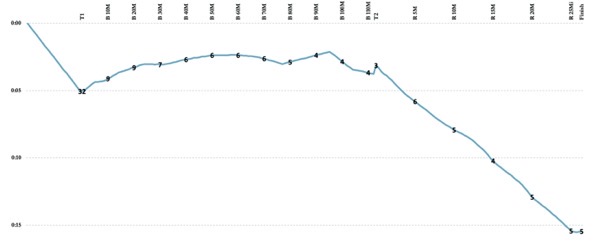
As in 2017, he came out of the water with Sebastian Kienle and Lionel Sanders. Cam had a great swim at IM Italy just three weeks before Kona and in 2018 he was just three minutes behind Josh Amberger and the other fast swimmers – so he was probably hoping for a smaller gap at the start of the bike. But there have been a lot of reports that the swim conditions were quite a bit harder this year with more swell, and this probably impacted the not-quite-as strong swimmers such as Cam more than the strong swimmers such as Josh or Frodo. Cam’s swim time was about 90 seconds slower than last year.
After the swim, Cam was the most aggressive rider, at the turnaround on Kuakini, less than five miles into the bike, he was already working his way through the group of swimmers that were two minutes faster in the water, and it almost looked as if he’d be able to shake Sebi and Lionel who were 20 seconds back but also working their way forward. By the time everyone had passed the slightly faster swimmers, Cam took the lead closely followed by Sebi and Lionel. Cam said after the race that he didn’t quite have good legs as last year when he was able to work his way to the front by 20 miles, but he was still setting a faster pace than the swimmers he had already overtaken, and in the climb to Hawi the group got smaller and smaller. At the turn in Hawi the gap to the front was down to just over two minutes, but that’s pretty much where it stayed for most of the ride back into Kona. (It’s interesting to note that since 2013 – maybe even longer – the T2 leader in the men’s Kona race was always in the lead group in Hawi.) According to Boris Stein’s data the wattage dropped quite a bit on the return leg, and probably the wind also impacted the group’s ability to make up more time to the front. Cam mentions in his blog post that he either had to work against a headwind, shielding the rest of the group or was shielded by the group in the tailwind sections. It was only in the last section of the bike that Cam was able to ride away from the group, but Frodo put in another effort in the last 25k of the bike, and the gap grew again. Back in town Cam was third off the bike but 3:45 off the lead. With Boris Stein DNF’ing, for the third year in a row Cam had the fastest bike split in Kona.
Cam also had a solid run, a 2:55 was probably the best he could realistically hope for and another nice improvement after a 3:19 in 2017 and a 3:06 last year. He ran a controlled, even pace and was able to overtake two more “big names” in triathlon: Last year Javier Gomez was the first triathlete Cam was able to overtake on the run (when Javier ran out of gas at the end of the marathon), this year he was able to run by Lionel Sanders and Alistair Brownlee at around ten miles into the run when they had to pay for their aggressive pace on the section along Ali’i.
It’s interesting to speculate if Cam’s Kona performance was impacted by his race at IM Italy just three weeks before or if he’s just had “a bad day” in Kona. It’s clear that even with further improvements in the run he will need a cushion in T2, and consequently will have to continue to race aggressively on the bike. A faster swim might make things easier, but he will still need a few “matches” to burn on the bike in order to shake the better runners if he wants to place even higher up next year.
Sixth Place: Joe Skipper
After finishing seventh last year, Joe Skipper moved up one spot and claimed sixth place:
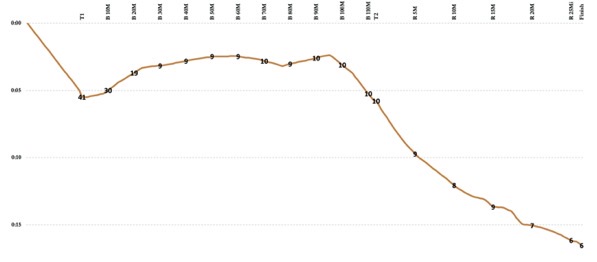
Last year, Joe was in the group with the fast bike riders out of the water (just 3 seconds behind Cam Wurf) but then was not quite able to match the pace Cam Wurf set at the start of the bike, falling back to the second big bike group that was able to make up time in the second half of the bike. This year Joe was also losing time to Cam at the start of the bike: At the Kuakini Turnaround after 5 miles he was about a minute behind and for a while he was dangling just off the end of the group. He had to put in some extra work in the first 25 miles to not get dropped and was the last one of the swim group to bridge up to the strong bike group. He stayed in that group of seven almost until T2 but had a flat five miles out. Fortunately, he quickly got a wheel change and only lost 90 seconds. He started the run in 10th place, after a bit of back and forth in the Energy Lab he was able to gain a few places, eventually finishing in sixth place with an even-paced 2:53 marathon.
Seventh Place: Braden Currie
After last year’s fifth place, Braden was again able to finish in the Top 10, but his day was very different from last year:
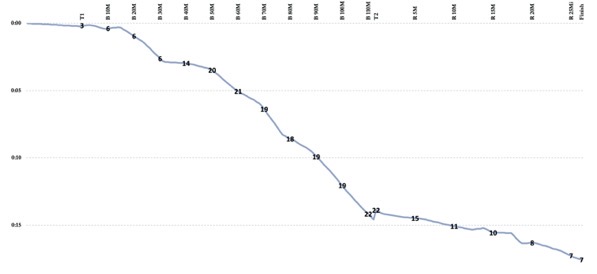
In 2018 Braden was quickly dropped from the front group in the swim, losing almost two minutes to the leaders. This year, he swam with the front group of eight athletes, starting the bike just ten seconds behind Josh Amberger. But while last year he was able to stay with the group on the bike, this year he was falling further and further back as the race progressed. It was only 12 miles before he fell out of the front group, then he was also dropped by the chase group in the climb to Hawi. At the turn he was five minutes behind the lead, and he lost further time on the ride back to Kona. By T2 he was more than 14 minutes behind the lead in 22nd place and about eight minutes behind the Top 10.
Often, athletes mentally struggle when they get dropped from the bike groups in Kona. Braden probably had some negative thoughts on the bike as well, but even if he was hoping for a better position at the start of the run he showed that he was still fully engaged. He set a solid pace in the first section of the run, and it only took him until mile 10 to move into Top 10. He continued with his even pace, running a 2:46 marathon (third-best of the day) and was able to climb into seventh place in the end.
Eight Place: Philipp Koutny
Philipp Koutny was a surprise in the Top 10 – before the race I had pegged his chances at only 9%:
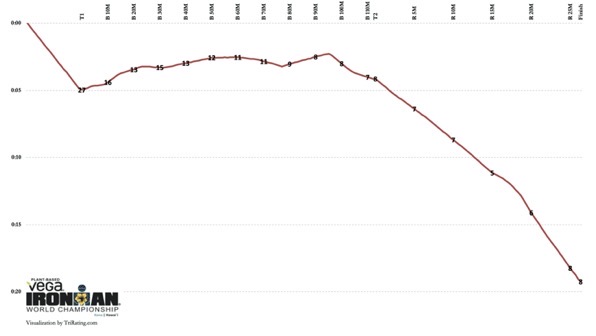
For the swim and bike, Philipp was able to stay with the chase group – he was never more than 15 seconds away from Sebi or Lionel. He was also running well even when others from the group started to struggle. He was fifth going into the Energy Lab, just a minute behind Cam. Philipp’s pace dropped slightly after that, but he only lost three spots to finish in eighth place.
Ninth Place: Bart Aernouts
Bart Aernouts delivered another Kona Top 10 performance:
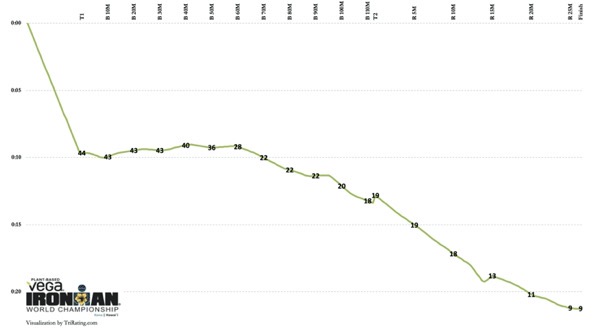
As is typical for Bart, he lost almost ten minutes to the leaders in the swim, starting the bike about five minutes behind the strong bike riders. Last year he was closer and found some company while working his way forward. This year he had to work on his own and wasn’t able to make up ground to the front. In the last section of the bike he was able to ride with Chris Leiferman and a few others, and he started the run in 18th place, about 13 minutes behind the front. Bart has the experience and patience to run well in Kona, slowly working his way towards the Top 10. Once on the Queen K, he was starting to overtake athletes struggling to run well, and at the start of the Energy Lab, shortly after the half-marathon mark, he was already in 13th place. On the way back into town he was able to overtake a few more and ended the race in ninth place. Usually at least one athlete from last year’s podium is able to finish on the podium the year after, but this year Bart was the only athlete from the 2018 male podium even finishing.
Tenth Place: Chris Leiferman
Chris Leiferman was the best-placed male rookie in Kona 2019:
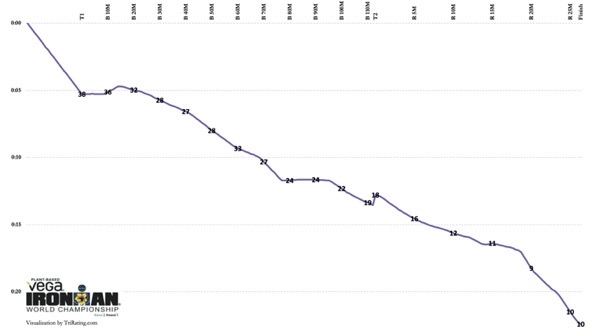
In his first race in Kona, Chris had a decent swim and exited the water with the strong bikers. When they picked up the pace to chase the lead group, he let them go after about 20 miles. He continued to lose time to the front but was probably able to ride his own pace and save his energy for the final part of the race. He started the run with Bart Aernouts in 18th place and slowly worked his way forward. By the Energy Lab he had climbed into 9th place. He struggled a bit on the way home, but only lost one spot (to Bart) and finished in the last money spot.
Going Well for Some Time: Josh Amberger, Maurice Clavel, Alistair Brownlee, Lionel Sanders
Here’s a look at a few more notable athletes who were in a good position for at least part of the race:
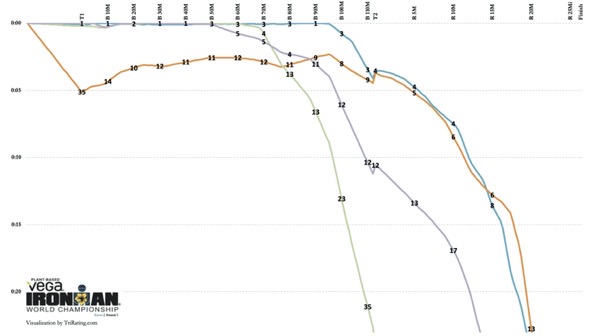
As in 2017 and 2018, Josh Amberger had the fastest swim of the day, even if this year’s conditions didn’t favor an attack on the swim course record. He seemed to get the pace “just right” in order not to be isolated on the bike but also creating decent separation from the front group to the chasers. He was riding with the front group but then fell back in the climb to Hawi, at the turn he was 45 seconds behind. He continued to lose time, but it took the chase group until mile 80 before catching him. Josh was not able to stay with them and then lost a lot more time in the last section of the bike. He reached T2 with a gap of 11 minutes to the front and 7 minutes to the chase group. He then finished the race with a 3:25 marathon in 33rd place.
Maurice Clavel was also able to swim with the front and even doing some work in the climb up to Hawi. But then he “popped” after 65 miles and lost almost 23 minutes in the last 100 minutes of the bike. He did not recover on the run, finishing in 38th place.
Alistair Brownlee was in the mix for a good while longer. After swimming with Josh, he was pushing the pace in the early part of the bike and seemed a bit surprised that he had a 20 second lead after the out-and-back through Kona. After that he settled into the front group and let Maurice Clavel do the work in the climb to Hawi. He fell back after the turnaround at Hawi: German television reported a drafting penalty, but it turned out to be a fast wheel change after a slow leak. He quickly worked his way back to the front group, at the first timing mat nine and a half miles after Hawi he was already back in the group, just two seconds behind Frodo. Apparently he let Frodo and TO know that he wasn’t too happy that they hadn’t waited for him (but how would they know what was going on with him?) and Frodo said after the race that it was a sign to him that Ali was working at his limit. When Frodo pushed the pace in the final 15 miles of the bike, Ali was the last one to fall back but then lost four minutes to Frodo and entered T2 with the chase group.
After his injury worries for most of the season, Lionel Sanders had a decent swim in the chase group with the other strong bikers Cam Wurf and Sebastian Kienle. He was able to ride the whole bike leg with that group, starting the run just four minutes behind the lead. Both Ali and Lionel surged at the start of the run, moving into third and fourth place on Ali’i Drive. But then they started to struggle after the turnaround, 3.7 miles into the marathon and as soon as they were on the Queen K they lost more and more time to the front. Misery loves company, and the two of them run-walked the rest of the marathon together, finishing 21st and 22nd with 3:13 marathons.
DNFs: Patrick Lange, Boris Stein
There were quite a few athletes who traveled to Kona with hopes of a good result, only to have to see their days end much earlier than anticipated:
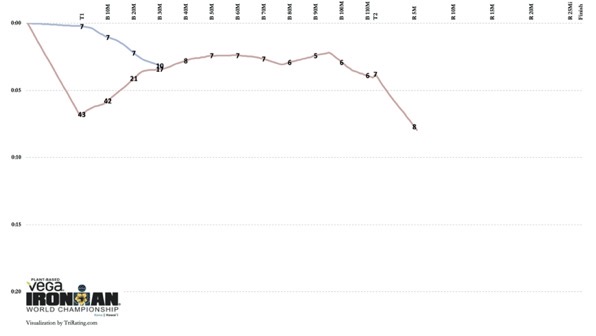
Most notably, defending champion Patrick Lange called it a day after just two and a half hours, reportedly blacking out after coming down with a fever just before the race. It seems that he decided to take some more risks than usual in the swim and was able to stay with the front group. But once on the bike, he immediately started to fall back. At the turn on Kuakini after five miles he was already 30 seconds back and had lost contact with the lead group. After 30 miles the chase group caught up with him, and he wasn’t able to stay with them either. He pulled out shortly after that when passing by a few spectators at the side of the road near the turnoff to Waikoloa. It’s an interesting coincidence that Björn Geesmann was taking care of him – who has since become his new coach. (It’s not apparent on the graph above that the group had passed him as he dropped out before the making it to the next timing mat which would have shown a gap.)
Another athlete who DNF’d is Boris Stein. Boris has been struggling with injuries for the last two seasons, and it seems he started the race knowing that he probably wouldn’t be able to finish – and in fact he pulled out shortly after starting the run. Boris is usually the slowest swimmer to make it into the big bike group, and this year was no difference: He exited the water seven minutes behind the leaders but just 90 seconds behind the strong bike riders. It took him 30 miles to ride up to them and then stayed in that group until T2. According to Cam Wurf he put in some short surges to ride away from them but wasn’t able to make his efforts stick and consequently just ended up wasting energy. He might have chosen a different race plan had he been healthy.
Photo Credits: Jan Frodeno by James Mitchell, Tim O’Donnell and Sebastian Kienle by Ingo Kutsche Photo.
